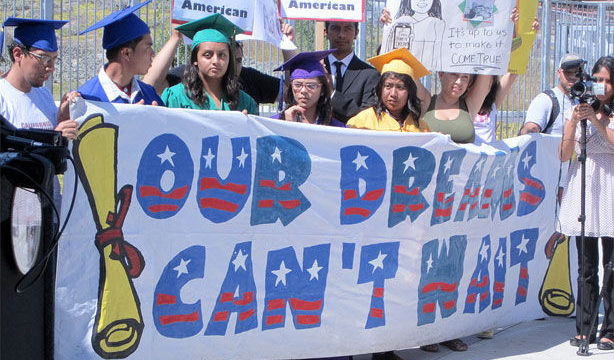This post was written by Donna Seymour, advocate and member of the St. Lawerence County Branch of AAUW-NYS as part of our PowHer the Vote 2017 campaign.
Political disconnects between the People and the Government (as embodied by the Trump Administration) are the order of the day in 2017. Caught in the middle are group of young people known as the Dreamers. Brought to the United States by their parents as children, the Dreamers took a big chance in 2012 when they came out of the shadows through DACA.
The Deferred Action for Childhood Arrivals, or DACA, was American immigration policy established by the Obama administration in 2012 that allowed some individuals who entered the country as minors, and had either entered or remained in the country illegally, to receive a renewable two-year period of deferred action from deportation and to be eligible for a work permit.
As of this year, approximately 800,000 individuals—referred to as Dreamers after the DREAM Act bill—were enrolled in the program created by DACA. The policy was rescinded by the Trump administration in September 2017.
Elections have consequences, as many have observed, and none more so that the election of 2016, which turned our national policy on its head in many areas. As it turns out, one of those big disconnects is between what citizens of the US think about the Dreamers and what the government wants to do with (or to) them:
Most Americans, 83%, think “dreamers” should be allowed to remain in the United States. This includes nearly six in ten Americans, 58%, who think “dreamers” should be permitted to stay and become citizens and 25% who believe they should be granted legal residency but not citizenship. Only 12% of U.S. residents say “dreamers” should be deported. Not surprisingly, there is a partisan divide. But, even 74% of Republicans, including a plurality — 42% — who say “dreamers” should be allowed to become citizens, oppose deportation. Most Democrats, 95%, and independents, 81%, say “dreamers” should be allowed to remain in the United States.
Like many other dilemmas faced in this country, the current situation is a direct result of inaction by Congress. The Dream Act, which has been languishing in Congress for the last 16 years, would create a pathway to legalize the status for these 800,000 young immigrants brought here illegally by their parents – if it were passed by Congress and signed into law by a president.
When Mr. Trump announced the end of DACA, the response was swift – depending on where you live. Here in New York, both state and municipal leaders were quick to protect the Dreamers who live in the state. Both Governor Andrew Cuomo and Attorney General Eric Schneiderman promised legal action to protect those DACA residents, if President Donald Trump succeeded in ending the program.
There are about 30,000 New Yorkers who would be impacted by the DACA repeal who live in New York City alone. Another 20,000 reside in upstate New York.
At the state level, Gov. Cuomo issued Executive Order 170 to prohibit state agencies and officers from inquiring about or disclosing an individual’s immigration status unless required by law or necessary to determine eligibility for a benefit or service. Law enforcement officers were also prohibited from inquiring about immigration status unless investigating illegal criminal activity. This prohibition against inquiring into status included, but was not limited to, when an individual approaches a law enforcement officer seeking assistance, is the victim of a crime, or is witness to a crime.
“As Washington squabbles over rolling back sensible immigration policy, we are taking action to help protect all New Yorkers from unwarranted targeting by government,” Governor Cuomo said. “New York became the Empire State due to the contributions of immigrants from every corner of the globe and we will not let the politics of fear and intimidation divide us.”
Cities like New York and Syracuse were quick to declare themselves “sanctuary cities” and to press for legal action. Syracuse joined other cities, counties and national organizations in supporting a Chicago lawsuit challenging the new regulations by the Justice Department that target sanctuary cities. In mid-September, a federal judge did block the Trump administration’s rules requiring so-called sanctuary cities to cooperate with immigration agents in order to get a public safety grant.
“I want to be clear, this is not just a victory for the city of Chicago,” Mayor Rahm Emanuel said. “It is a win for cities, counties and states across the country who also filed amicus briefs on behalf of our lawsuit, and also the business leaders who also stepped forward on our lawsuit.”
When Attorney General Jeff Sessions threatened law enforcement funding, another federal court stopped him from withholding public-safety grants to the sanctuary cities. The decision issued was a setback to the administration’s efforts to force local jurisdictions to help federal authorities crack down on illegal immigration.
Putting the immigration status of these young people into limbo has consequences far beyond their ability to go to school or work. About 450,000 of them will forfeit health insurance and other benefits offered through employers, according to the National Immigration Law Center. Another 290,000 recipients could lose their eligibility for state-subsidized health coverage when their protection expires. More than half of DACA beneficiaries will be forced to relinquish driver’s licenses, as well as most occupational licenses, like those required for nursing and cosmetology.
New York is one of the few states that provides health insurance to non-citizens, or people residing under the color of law (PRUCOL). That’s because of a 2001 Court of Appeals ruling that said denying Medicaid to any legal resident violated the equal protection clauses of the New York and U.S. constitutions. As a result, immigrants in New York who are not citizens, but are living in the state lawfully, are entitled to Medicaid. Because the federal government does not recognize the state court’s decision, New York, which usually receives a 50 percent match for Medicaid expenses, pays the full cost for insuring these immigrants. If they lose their DACA status and revert to being undocumented immigrants in the eyes of the law, they may also lose their right to Medicaid.
Tens of thousands of dreamers are enrolled in schools – both public schools and colleges. State education leaders were quick to stand up for them. The New York State Education Department issued a statement condemning the president’s action.
“By ending the DACA program, President Trump ignores the vast contributions Dreamers have already made to our nation’s economy and society, as well as their vast potential for future contributions. Now it is time for our Congressional leaders to demonstrate true leadership and embrace Dreamers for what they are – productive, hard-working, tax-paying members of our communities.”
How this situation will end for the Dreamers has yet to be determined, but your municipal votes this fall could determine how your city, town or county reacts to these and other policy reversals from the federal government. It is pretty clear that the Trump Administration has lost the support of the governed in many states and areas on this question.
But as AAUW Chief Executive Officer Kimberly Churches pointed out, this is fundamentally a civil rights issue:
“AAUW is proud to be part of a community that fights for the civil rights of all Americans, including immigrants. We stand, and will continue to stand, with the nearly 800,000 Dreamers and DACA recipients. This action by the Trump administration is a firm rejection of one of America’s founding principles: that with hard work and education anyone can achieve their own version of the American dream. AAUW will continue to stand by immigrant students and strongly defend their right to an education. The future of our nation depends on it.”
And civil rights – for ourselves and others – should always be one of the ideals we carry into the voting booth each November.
This post originally appears on Donna Seymour’s blog and can be viewed here.


